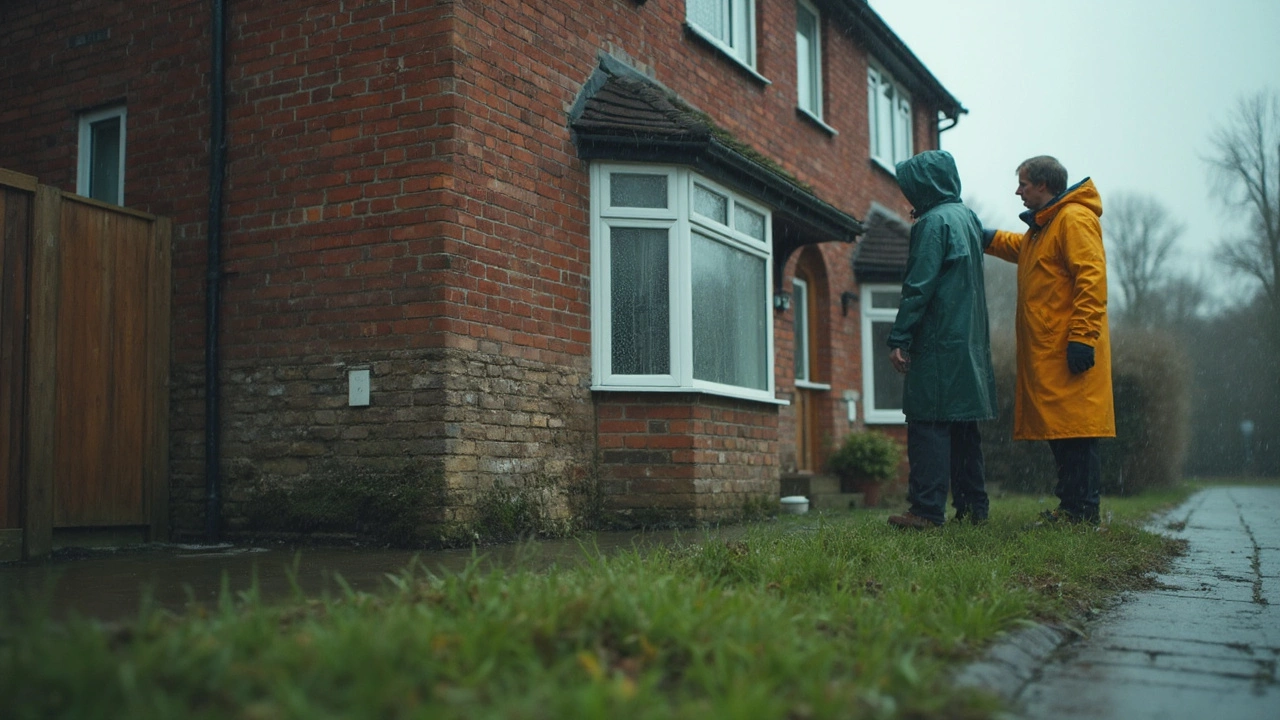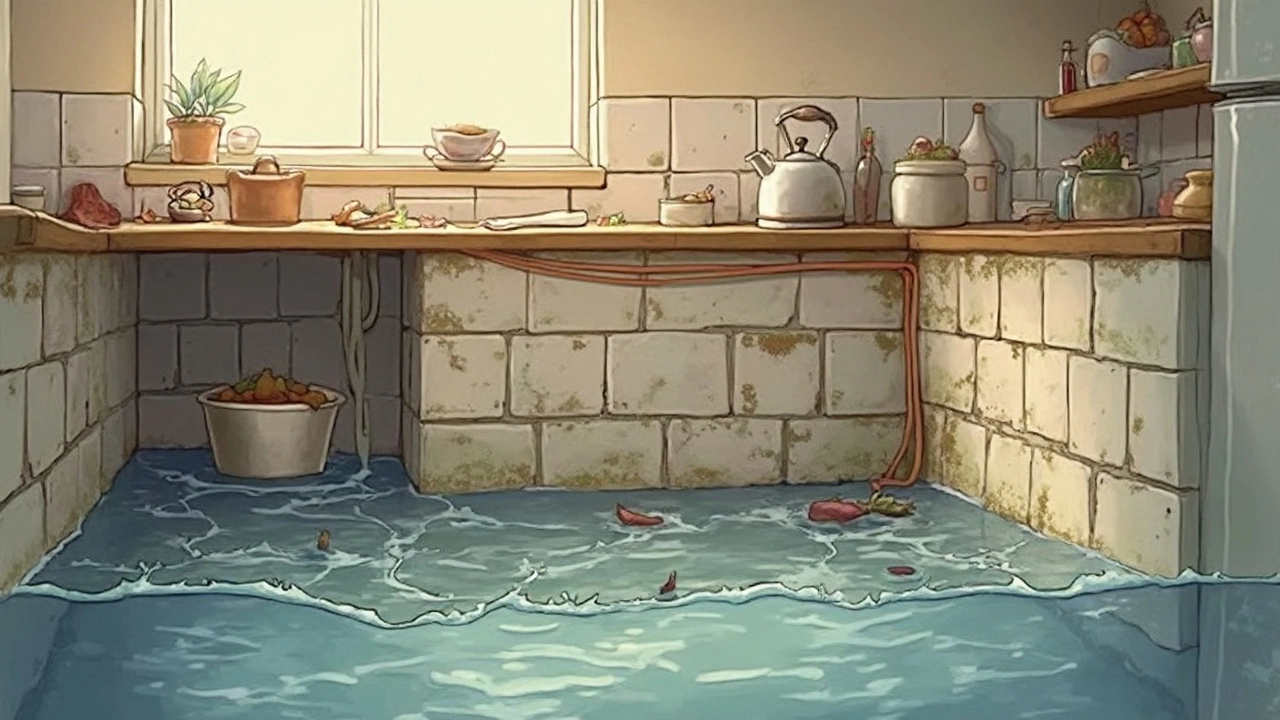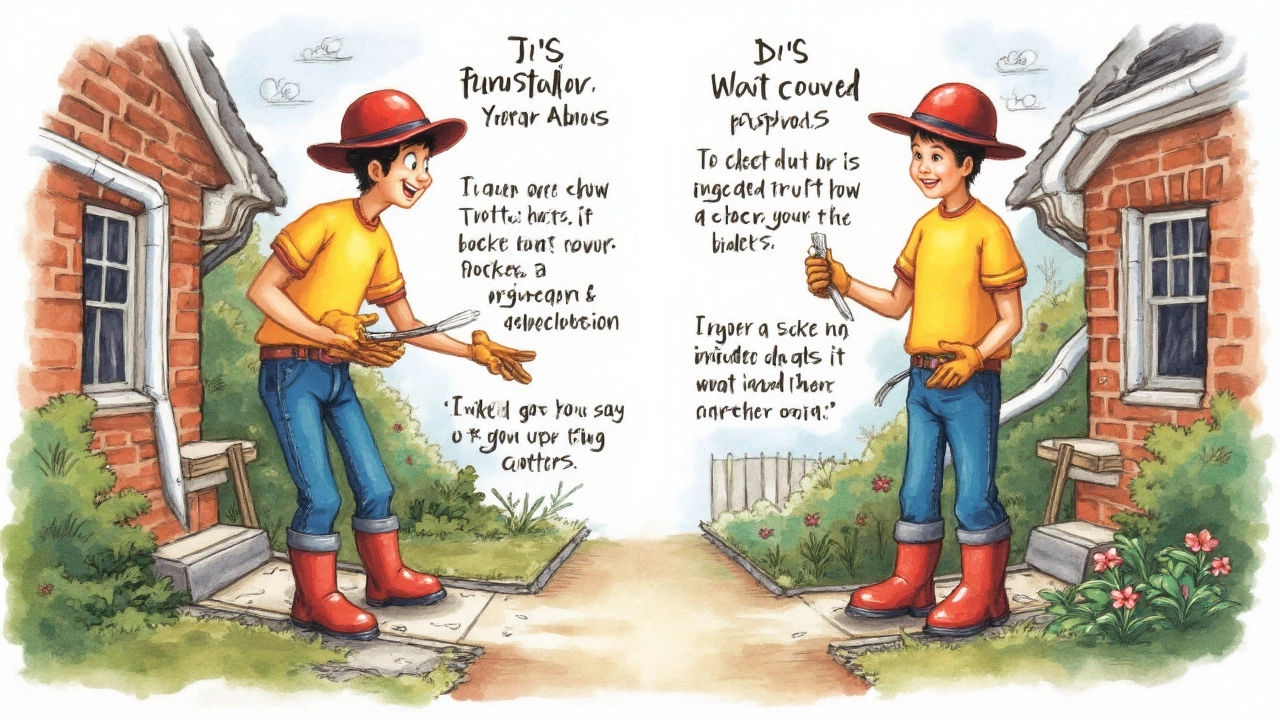Water Damage to Foundation: What It Really Looks Like
 May, 8 2025
May, 8 2025
If you ever spot hairline cracks zigzagging up your basement wall, or puddles waving hello after a rainstorm, your foundation might be in trouble from water damage. Most folks never notice foundation problems until something major happens—like that stubborn door that suddenly won’t close, or your floors taking on a bouncy feeling.
Water doesn’t need much of an opening. It sneaks down next to your home whenever gutters leak or soil slopes the wrong way. Once water hangs out around your foundation, concrete starts to weaken, slowly and quietly. You don’t always see dramatic flooding. Sometimes it’s just musty smells downstairs, peeling paint near the floor, or tiny bits of white powder (that’s called efflorescence) crawling up the wall.
Here’s the wild part: Rufus, my dog, will sniff around a damp corner weeks before I spot a leak. Trust your pets (and your nose). If things don’t look or smell right, don’t ignore it. Water damage to your foundation isn’t just ugly—it can send your repair bills through the roof.
- The Science Behind Water Damage
- Obvious Visual Signs Outside and Inside
- Hidden Warning Signs Homeowners Miss
- Long-Term Impact on Your Home
- Simple Ways to Prevent Foundation Water Damage
The Science Behind Water Damage
Water is simple, but it can be a silent wrecking ball for your foundation. Just a few inches of water around your home’s base can start trouble, even if you don’t see a pool. The real issue kicks in when water seeps into the ground and puts pressure—engineers call it "hydrostatic pressure"—on your foundation walls. Over time, this pushes in against the concrete, which isn’t built to flex or move the way water does.
Concrete looks solid, but it’s actually full of microscopic holes. Water finds these weak points, seeps inside, and can even freeze and expand in colder months. That freeze-thaw cycle makes cracks worse. Then, as moisture sticks around, you might see mold, mildew, or the classic white streaks of efflorescence forming on the wall surface.
Bad drainage ramps up this process. Gutters that dump water too close to the foundation or a yard that tilts toward your house can create a nonstop soaking effect. When soil is too wet, it swells and presses inward. Later, when it dries and shrinks, it leaves empty gaps where water can gather fast in the next rainstorm.
- Hydrostatic pressure is the main reason for foundation cracks and leaks.
- Winter freeze-thaw cycles take cracks from small to huge in just a few years.
- The type of soil you have (like clay vs. sand) changes how water moves and sits around your foundation.
Here’s a quick peek at how much water a simple rainstorm can mean for your foundation:
| Rainfall (Inches) | Gallons per 1,000 sq ft Roof |
|---|---|
| 1 | 623 |
| 2 | 1,246 |
That’s just from your roof! If your gutters or downspouts aren’t working, all that water flows straight to your foundation and starts the damage process. Stay sharp to these basic science facts so you can spot and stop foundation problems before they blow up your budget. And remember, the water damage you catch early is always cheaper to fix.
Obvious Visual Signs Outside and Inside
You can spot water damage to your foundation just by walking around your house and peeking in a few spots. Outside, watch for cracks in the concrete or brick. Little vertical lines aren’t a big deal, but if you see horizontal or stair-step cracks—especially wider than a quarter’s thickness—that’s a red flag. Foundation walls should look solid and straight, not bulged or caved in.
Check near the bottom of outside walls for dark stains or moss. These are a tip-off that water sits against your house after it rains. Efflorescence—a chalky white residue—shows up when water pulls salts from the masonry, leaving tracks behind.
Head inside, especially to the basement or crawl space. Damp patches, moldy smells, and peeling paint low on walls are all classic signs of trouble. Doors or windows sticking suddenly can mean the frame is shifting as the foundation moves. You might even see a gap where the floor meets the wall, or notice the floor isn’t level if you roll a ball and it doesn’t stop where you expect.
- Cracks wider than a pencil outside or inside
- Discolored or crumbling concrete/masonry
- Puddles or wet spots on basement floors
- Musty odors and visible mold
- Buckling wood or tile flooring
Here’s some quick data for perspective. Studies show that almost 60% of U.S. homes deal with wet basements at some point, and nearly 40% have some kind of ongoing water-related foundation issue. Catching visual signs early can save you from more expensive repairs later.

Hidden Warning Signs Homeowners Miss
Don’t let a spotless living room fool you—water damage loves to hide where nobody checks. Most homeowners think about giant cracks or puddles, but smaller clues slip right past. These hidden signs often mean the damage below is growing.
If you notice soft spots or little dips in your carpets, don’t just blame it on heavy furniture or a hyper dog. That squishy feeling could point to moisture sneaking up from under the slab. Discoloration in basement corners isn’t just old paint; it can mean the concrete is leaking or soaking up water. And tiny rust spots on metal storage shelves or appliances—the ones sitting on your basement floor? That’s a classic sign the air down there has too much moisture. Mold doesn’t always pop up in giant patches either. Sometimes it’s a little streak, a mild earthy smell, or a white fuzzy line where the wall meets the floor.
- Doors or windows that suddenly stick or don’t latch right—foundations shift when wet soil pushes on them.
- Walls bows inward, especially in basements, even by half an inch, mean water pressure is building outside.
- Baseboards or drywall pulling away from the wall may look like bad construction, but water damage weakens the fasteners holding them on tight.
- Laminated or wood floors cupping or buckling—a sneaky hint that water’s seeping underneath.
Every year, insurance data shows that about 1 in 50 homeowners makes a claim for water damage. Foundation leaks often rank among the costliest because they’re so easy to miss early on when they’re cheapest to fix. Here’s a quick rundown of features and what they can mean:
| Sign | Possible Cause |
|---|---|
| Rusty nail heads on drywall | Moisture wicking through walls |
| Musty smells after rain | Underground water pooling |
| Small white (salty) flakes | Efflorescence from water-damaged concrete |
| Sudden cracks above doors/windows | Foundation shifting from water |
If you spot any of these issues, your foundation’s not just dirty—it may be facing water damage that can only get worse. These signs rarely fix themselves, and waiting is never your friend here. So, check your basement and crawlspaces at least twice a year, and don’t shrug off a weird smell or a sticky door. Your wallet will thank you later.
Long-Term Impact on Your Home
Water damage to the foundation isn’t just today’s headache—it can haunt you for years if you ignore it. When water keeps creeping in, concrete can crack and crumble, making your home less safe and comfortable. One eye-opening stat: around 60% of houses in the U.S. deal with some kind of below-ground wetness, which means this isn’t just a rare fluke.
If you let foundation repair slide, the structure can literally shift. Doors and windows go crooked, walls bow, and those cool new “vintage” sloping floors? Not as charming as they sound. Cracks wider than a quarter-inch could mean your house is settling unevenly, putting real stress on beams and joints.
Another big deal: mold and rot. When water gets in, the damp sticks around. That’s prime real estate for mold, which loves dark, wet spots under your house. Not only does it stink, but it can make allergy or asthma problems way worse.
If you ever plan to sell, foundation water damage is money down the drain. Buyers (and inspectors) spot cracks and stains fast. A damaged foundation can chop off thousands, sometimes tens of thousands, from your home’s value. Insurance usually doesn’t cover “neglected maintenance” either, so you’re on the hook.
Here’s a quick look at how water damage can stack up over time:
| Problem | Cost to Fix (Average 2024) |
|---|---|
| Minor cracks | $500 - $1,500 |
| Sticking doors/windows | $800 - $2,500 |
| Major structural repair | $8,000 - $25,000+ |
| Mold remediation | $2,000 - $6,000 |
Bottom line: catching water issues early can save you from bigger, nastier problems. Even small fixes can stop the snowball before it turns into an avalanche for your budget and your home’s stability.

Simple Ways to Prevent Foundation Water Damage
Keeping water away from your foundation isn’t rocket science, but a lot of homeowners still miss out on the basics until they’re dealing with a soggy basement. Here are some everyday things you can do to stay ahead of problems and protect your house from water damage:
- Check your gutters and downspouts. Clean out leaves and gunk at least twice a year. Make sure downspouts extend at least 6 feet away from your house so water doesn’t pool next to your foundation. If you spot a waterfall of rain right where your roof meets the wall, grab a ladder and clear that jam.
- Look at the slope around your house. Dirt should slope away from your foundation, at least 6 inches over the first 10 feet. If you see water standing close to where your walls meet the ground after rain, you may need to add or re-grade soil.
- Seal the cracks. Tiny cracks in your basement or crawlspace walls can let water sneak in. Use concrete caulk or epoxy to seal them up before they turn into bigger issues.
- Check your sprinkler systems. Make sure sprinklers don’t shoot water against your foundation. Adjust their direction, especially in the spring and summer.
- Install a sump pump or French drain. If your basement has a history of getting wet, a sump pump can keep water out, and a French drain can redirect far more water than you’ll manage with just grading soil or fixing gutters.
Here’s a quick breakdown of how much water even a mild rainstorm can send your way:
| Roof Size (sq ft) | 1 inch Rainfall (gallons) |
|---|---|
| 1000 | 620 |
| 2000 | 1,240 |
So even a regular-sized roof can dump over a thousand gallons of water in just one storm. If your drainage isn’t up to snuff, that’s a lot of water pounding your foundation every time the clouds roll in.
Walk around your house after a heavy rain. See if you spot any new puddles, mud against the foundation, or paint that’s flaking at ground level. Catching these little things early will save you a fortune in foundation repair later.
